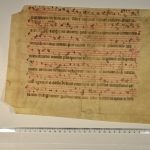The fragments F 764 and F765 belong to the same mother codex and are torsos of the same leaf. Between the upper (F 765) and the lower (F 764) part approximately one line of text and music is missing.
The characteristic shapes of the neumes ‒ the pes stepping a 2dn and facing left with both components, the scandicus built-up of similarly left-aligned puncta ‒ show the Wrocław variant of Central-European Messine-German Gothic notation types.
The first Vespers and the beginning of the Matins of Saint Augustin’s historia Laetare mater nostra can be reconstructed from the two fragments. On the basis of the selection and ordering of the chants ‒ above all, the lack of responsory in the Vespers ‒ Mezey assumed that the codex belonged to the Order of Hermits of St. Augustine. However, the lack of the responsory in the first Vespers doesn’t justify this statement, which is otherwise sharply contradicted by the notation of the manuscript. The historia Laetare mater was popular throughout Europe; if not consistently, but sporadically it occurs in several diocesan office traditions in Central Europe.
Zsuzsa Czagány



